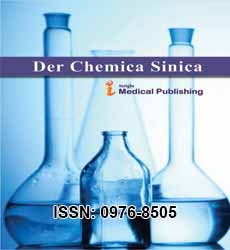ISSN : 0976-8505
Der Chemica Sinica
Ionic Holding of Substance Bond that Includes the Electrostatic Fascination
Christo Boyadjiev*
Department of Chemical Engineering, Bulgarian Academy of Sciences, Bulgaria
- *Corresponding Author:
- Christo Boyadjiev
Department of Chemical Engineering, Bulgarian Academy of Sciences, Bulgaria
E-mail:chris.boyardjiev@gmail.com
Received date: February 01, 2022, Manuscript No. IPDCS-22-13077; Editor assigned date: February 08, 2022, PreQC No. IPDCS-22-13077 (PQ); Reviewed date:February 15, 2022, QC No. IPDCS-22-13077; Revised date:February 21, 2022, Manuscript No. IPDCS-22-13077 (R); Published date:March 01, 2022, DOI: 10.36648/0976-8505.13.3.5
Citation: Boyadjiev C (2022) Ionic Holding of Substance Bond that Includes the Electrostatic Fascination. Der Chem Sin Vol.13 No.3: 005.
Description
A particle is a gathering of at least two iotas kept intact by substance bonds; contingent upon setting, the term could possibly incorporate particles which fulfill this criterion. In quantum material science, natural science, and organic chemistry, the qualification from particles is dropped and atom is many times utilized while alluding to polyatomic particles. In the motor hypothesis of gases, the term atom is frequently utilized for any vaporous molecule no matter what its synthesis. This loosens up the prerequisite that a particle contains at least two iotas, since the honorable gases are individual atoms. A particle might be homonuclear, that is to say, it comprises of iotas of one substance component, for example two particles in the oxygen atom (O2); or it could be heteronuclear, a substance compound made out of more than one component, for example water (two hydrogen particles and one oxygen molecule; H2O). Particles and edifices associated by non-covalent cooperation’s, for example, hydrogen bonds or ionic bonds, are commonly not considered single molecules.
Supplement Minerals and Large Ionic Mixtures
Atoms as parts of issue are normal. They additionally make up the majority of the seas and environment. Most natural substances are particles. The substances of life are particles, for example proteins, the amino acids of which they are made, the nucleic acids (DNA and RNA), sugars, starches, fats, and nutrients. The supplement minerals are by and large ionic mixtures; accordingly they are not particles, for example iron sulfate.
Be that as it may, most of recognizable strong substances on Earth are made part of the way or totally of gems or ionic mixtures, which are not made of atoms. These incorporate every one of the minerals that make up the substance of the Earth, sand, mud, stones, rocks, stones, bedrock, the liquid inside, and the planet's center. These contain numerous substance bonds, however are not made of recognizable atoms.
No normal particle can be characterized for salts nor for covalent gems, albeit these are frequently made out of rehashing unit cells that broaden either in a plane, for example graphene; or three-correspondingly for example precious stone, quartz, sodium chloride. The subject of rehashed unit-cell structure additionally holds for most metals which are dense stages with metallic holding. In this way strong metals are not made of atoms.
In glasses, which are solids that exist in a glassy scattered express, the particles are kept intact by synthetic bonds without any presence of any determinable atom, nor any of the routineness of rehashing unit-cell structure that portrays salts, covalent precious stones, and metals.
Ionic holding is a sort of substance bond that includes the electrostatic fascination between oppositely charged particles, and is the essential association happening in ionic mixtures. The particles are molecules that have lost at least one electron (named cations) and iotas that have acquired at least one electron (named anions). This exchange of electrons is named electrovalence as opposed to covalence. In the most straightforward case, the cation is a metal particle and the anion is a nonmetal iota, however these particles can be of a more convoluted nature, for example sub-atomic particles like NH4+ or SO42−. At ordinary temperatures and tensions, ionic holding generally makes solids (or at times fluids) without independent recognizable particles, however the vaporization/sublimation of such materials produces separate atoms where electrons are as yet moved completely enough for the securities to be viewed as ionic as opposed to covalent.
Most atoms are tiny to be seen with the unaided eye, in spite of the fact that particles of numerous polymers can arrive at naturally visible sizes, including biopolymers like DNA. Particles generally utilized as building blocks for natural union have a component of a couple of angstroms to a few dozen Å, or around one billionth of a meter. Single particles can't as a rule be seen by light (as indicated above), yet little particles and, surprisingly, the blueprints of individual iotas might be followed in certain conditions by utilization of a nuclear power magnifying instrument. Probably the biggest atoms are macromolecules or super molecules.
Sub-Atomic Recipe Mirrors
The sub-atomic recipe mirrors the specific number of iotas that create the particle thus portrays various atoms. Anyway various isomers can have a similar nuclear arrangement while being various particles. The experimental recipe is many times equivalent to the atomic equation yet not generally. For instance, the atom acetylene has sub-atomic recipe C2H2, yet the easiest whole number proportion of components is CH. For particles with a muddled 3-layered structure, particularly including iotas clung to four distinct substituents, a basic atomic equation or even semi-primary synthetic recipe may not be to the point of totally indicating the particle. For this situation, a graphical kind of equation called a primary recipe might be required. Primary equations may thusly be addressed with a one-layered compound name, yet such substance terminology requires many words and terms which are not piece of synthetic recipes. Sub-atomic spectroscopy manages the reaction (range) of particles collaborating with examining signs of known energy (or recurrence, as per Planck's equation). Atoms have quantized energy levels that can be broke down by recognizing the particle's energy trade through absorbance or emission. Spectroscopy doesn't by and large allude to diffraction concentrates on where particles like neutrons, electrons, or high energy X-beams connect with a customary course of action of atoms (as in a gem).
Microwave spectroscopy ordinarily gauges changes in the pivot of particles, and can be utilized to recognize atoms in space. Infrared spectroscopy estimates the vibration of atoms, including extending, bowing or curving movements. Distinguishing the sorts of bonds or utilitarian gatherings in molecules is generally utilized. Changes in the game plans of electrons yield assimilation or emanation lines in bright, noticeable or close to infrared light, and result in variety. Atomic reverberation spectroscopy estimates the climate of specific cores in the particle, and can be utilized to portray the quantities of iotas in various situations in an atom.

Open Access Journals
- Aquaculture & Veterinary Science
- Chemistry & Chemical Sciences
- Clinical Sciences
- Engineering
- General Science
- Genetics & Molecular Biology
- Health Care & Nursing
- Immunology & Microbiology
- Materials Science
- Mathematics & Physics
- Medical Sciences
- Neurology & Psychiatry
- Oncology & Cancer Science
- Pharmaceutical Sciences
